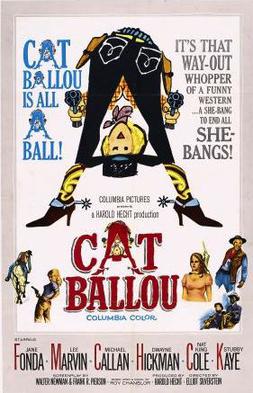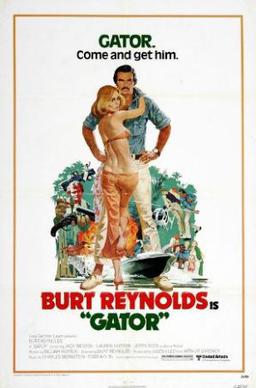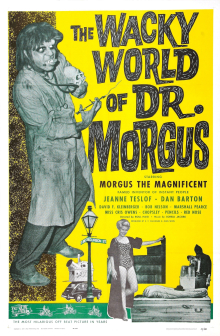
The Defiant Ones is a 1958 American drama film which tells the story of two escaped prisoners, one white and one black, who are shackled together and who must co-operate in order to survive. It stars Tony Curtis and Sidney Poitier.

Cat Ballou is a 1965 American western comedy film starring Jane Fonda and Lee Marvin, who won an Academy Award for Best Actor for his dual role. The story involves a woman who hires a notorious gunman to protect her father's ranch, and later to avenge his murder, only to find that the gunman is not what she expected. The supporting cast features Tom Nardini, Michael Callan, Dwayne Hickman, and Nat King Cole and Stubby Kaye, who together perform the film's theme song, and who appear throughout the film in the form of travelling minstrels or troubadours as a kind of musical Greek chorus and framing device.

Curtis Lee Hanson was an American film director, screenwriter, and producer. Born in Reno, Nevada, Hanson grew up in Los Angeles. After dropping out of high school, Hanson worked as photographer and editor for Cinema magazine. In the 1970s, Hanson got involved in filmmaking starting with participating in the writing of the horror film The Dunwich Horror (1970) and his directorial debut Sweet Kill (1973), where he lacked creative control to fulfill his vision. While Hanson continued directing, he rose to prominence by being involved in the writing of several critically-acclaimed films. This included Daryl Duke's The Silent Partner (1978), Samuel Fuller's White Dog (1982), and Carroll Ballard's Never Cry Wolf (1983).

Pogo was a daily comic strip that was created by cartoonist Walt Kelly and syndicated to American newspapers from 1948 until 1975. Set in the Okefenokee Swamp in the Southeastern United States, Pogo followed the adventures of its anthropomorphic animal characters, including the title character, an opossum. The strip was written for both children and adults, with layers of social and political satire targeted to the latter. Pogo was distributed by the Post-Hall Syndicate. The strip earned Kelly a Reuben Award in 1951.

The Okefenokee Swamp is a shallow, 438,000-acre (177,000 ha), peat-filled wetland straddling the Georgia–Florida line in the United States. A majority of the swamp is protected by the Okefenokee National Wildlife Refuge and the Okefenokee Wilderness. The Okefenokee Swamp is considered to be one of the Seven Natural Wonders of Georgia and is the largest "blackwater" swamp in North America.

Charles Bronson was an American actor. He was known for his roles in action films and his "granite features and brawny physique". Bronson was born into extreme poverty in Ehrenfeld, Pennsylvania, a coal mining town in the Allegheny Mountains. Bronson's father, a miner, died when Bronson was young. Bronson himself worked in the mines as well until joining the United States Army Air Forces in 1943 to fight in World War II. After his service, he joined a theatrical troupe and studied acting. During the 1950s, he played various supporting roles in motion pictures and television, including anthology drama TV series in which he would appear as the main character. Near the end of the decade, he had his first cinematic leading role in Machine-Gun Kelly (1958).

Young Frankenstein is a 1974 American comedy horror film directed by Mel Brooks. The screenplay was co-written by Brooks and Gene Wilder. Wilder also starred in the lead role as the title character, a descendant of the infamous Dr. Victor Frankenstein. Peter Boyle portrayed the monster. The film co-stars Teri Garr, Cloris Leachman, Marty Feldman, Madeline Kahn, Kenneth Mars, Richard Haydn, and Gene Hackman.

Louis Cameron Gossett Jr. was an American actor. He made his stage debut at the age of 17. Shortly thereafter, he successfully auditioned for the Broadway play Take a Giant Step. Gossett continued acting onstage in critically acclaimed plays including A Raisin in the Sun (1959), The Blacks (1961), Tambourines to Glory (1963), and The Zulu and the Zayda (1965). In 1977, Gossett appeared in the popular miniseries Roots, for which he won Outstanding Lead Actor for a Single Appearance in a Drama or Comedy Series at the Emmy Awards.

Attack of the Giant Leeches is an independently made, 1959 black-and-white science fiction-horror film, produced by Gene Corman and directed by Bernard L. Kowalski. It stars Ken Clark, Yvette Vickers, Bruno VeSota and Jan Shepard. The screenplay was written by Leo Gordon. The film was released by American International Pictures on a double bill with A Bucket of Blood, and was retitled Demons of the Swamp for its UK release. Later, in some areas in 1960, Leeches played on a double bill with the Roger Corman film House of Usher.

Swamp Water is a 1941 American film noir crime film directed by Jean Renoir and starring Walter Brennan, Walter Huston and Anne Baxter. Based on the novel by Vereen Bell, it was produced at 20th Century Fox. The film was shot on location at Okefenokee Swamp, Waycross, Georgia, USA. It was Renoir's first American film. The film was remade in 1952 as Lure of the Wilderness, directed by Jean Negulesco.

Night Monster is a 1942 American black-and-white horror film featuring Bela Lugosi and produced and distributed by Universal Pictures Company. The movie uses an original story and screenplay by Clarence Upson Young and was produced and directed by Ford Beebe. For box office value, star billing was given to Bela Lugosi and Lionel Atwill, but the lead roles were played by Ralph Morgan, Irene Hervey and Don Porter, with Atwill in a character role as a pompous doctor who becomes a victim to the title character, and Lugosi in a small part as a butler.

The Mummy's Curse is a 1944 American horror film directed by Leslie Goodwins. Produced by Universal Pictures, it is the fifth entry in Universal's original Mummy franchise, serving as a sequel to The Mummy's Ghost (1944). It marks Lon Chaney Jr.'s final appearance as Kharis, an Egyptian mummy.

The Okefenokee National Wildlife Refuge is a 402,000‑acre (1,627 km2) National Wildlife Refuge located in Charlton, Ware, and Clinch Counties of Georgia, and Baker County in Florida, United States. The refuge is administered from offices in Folkston, Georgia. The refuge was established in 1937 to protect a majority of the 438,000 acre (1,772 km2) Okefenokee Swamp. Though often translated as "land of trembling earth", the name "Okefenokee" is likely derived from Hitchiti oki fanôːki "bubbling water".

Gator is a 1976 American action comedy film and a sequel to White Lightning starring and directed by Burt Reynolds in his directorial debut.
The Monster of Piedras Blancas is a 1959 American monster film. It was produced by Jack Kevan, directed by Irvin Berwick, and stars Jeanne Carmen, Les Tremayne, John Harmon, Don Sullivan, Forrest Lewis, and Pete Dunn. The film was released by Filmservice Distributors Corporation as a double feature with Okefenokee.

Monster Mansion is a mill chute ride at Six Flags Over Georgia located in Austell, Georgia. Aboard six-passenger boats, riders pass through nine scenes along the 700 foot-long flume, passing by over 107 original animatronic characters.

Okefenokee Swamp Park is located 12 miles south of Waycross, Georgia, United States. The park is accessed by taking the Vereen Bell Memorial Highway to the southern side of the Cowhouse Island. This is the northernmost entry point to the Okefenokee National Wildlife Refuge. The Okefenokee Swamp is the most extensive blackwater swamp in North America and covers over 438,000 acres.
Swamp Girl is a 1971 American backcountry drama film, independently made on a low budget in Georgia by Donald A. Davis Productions, Inc., co-produced and co-written by Don Davis, Jack Vaughn and Jay Kulp. The sole name billed before the title is that of country singer Ferlin Husky, with second billing going to country singer-songwriter Claude King. The title role is played by Georgia native Simone Griffeth who receives an "Introducing" credit in her film debut.
Richard "Dick" Flood, also known as Okefenokee Joe, was an American country music singer-songwriter, entertainer, and environmentalist. In the mid-1950s he was part of the duo The Country Lads and made regular appearances on CBS' The Jimmy Dean Show. In 1959, Flood's cover version of "The Three Bells " reached number 23 on the Billboard Hot 100. His songs have been recorded by other artists, including Roy Orbison, Anita Bryant, Billy Grammer, Kathy Linden, and The Wilburn Brothers. In 1962, The Wilburn Brothers recorded his song "Trouble's Back in Town", which peaked at number 4 on the US Country Chart and was named Cashbox Magazine’s "Country Song of the Year". In 1973, Flood moved to Georgia's Okefenokee Swamp and became a professional naturalist and environmentalist.

The Wacky World of Dr. Morgus is a 1962 American black and white horror film directed by Roul Haig. The cast includes Sid Noel, Dan Barton and David Kleinberger.

















